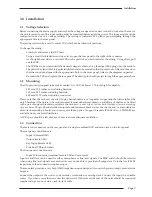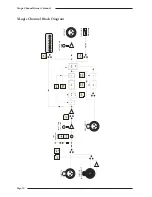
Appendix D – Calibration Information
The XLogic Channel unit is factory calibrated and should only need calibration if a potentiometer or other
component has been replaced or if it is suspected that there is a problem with calibration.
In all of the following instructions it is assumed that the lid has been removed and that power has been applied.
It is also assumed that unless otherwise specified, all switches are released and all potentiometers are at unity,
minimum or indent position as appropriate. The required accuracy for each adjustment will be specified along
with the target value.
All level and distortion measurements should be made with audio-band 20Hz to 20kHz filters unless otherwise
specified.
Microphone Input
Equipment Required:
Calibrated audio oscillator and audio level meter
Test Signal:
50Hz sinewave @ –12dBu, common mode
Input and Output:
Oscillator to Input A (or B) and Output to the audio level meter
Unit Setup:
Set the Input Gain to ‘36dB’ and the Output Gain to indent (0dB)
CMRR Trim
Adjustment:
On the 629602 card, adjust VR22 for minimum level (normally < –40dBu)
Output Stage
Equipment Required:
Calibrated audio oscillator and audio level meter
Test Signal:
1kHz sinewave @ –6dBu
Input and Output:
Oscillator to Input A (or B) and Output to the audio level meter
Unit Setup:
1. Set the Input Gain to ‘6dB’ and the Output Gain to indent (0dB).
2. Press HI-Z switch IN.
Unity Gain Trim
Adjustment:
On the 629603 (upper) card, adjust VR29 for 0dBu ±0.05dB
Meter Calibration
Equipment Required:
Calibrated audio oscillator and audio level meter
Test Signal:
1kHz sinewave @ –6dBu
Input and Output:
Oscillator to Input A (or B) and Output to the audio level meter
Unit Setup:
1. Set the Input Gain to ‘6dB’ and the Output Gain to indent (0dB).
2. Check for +24dBu output level.
Adjustment:
1. On the 629602 card, adjust VR26 (METER 0dB) until the ‘+24’ meter LED is just
illuminated.
2. Reduce oscillator level to +18dBu, then +12dBu etc. and check that the correct
meter LEDs light. At each point, reduce the level slightly using the Output Gain
control and check each LED extinguishes.
Appendix
Page 21
Summary of Contents for XLogic Super Analogue
Page 1: ...Super Analogue Channel Owner s Manual ...
Page 2: ......
Page 29: ...Notes Appendix Page 25 ...




















